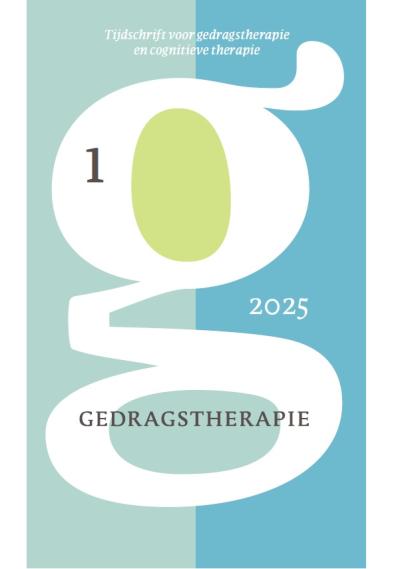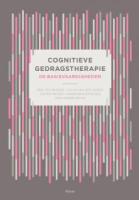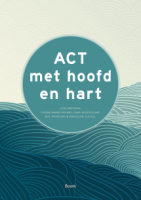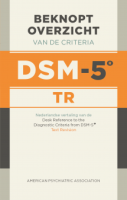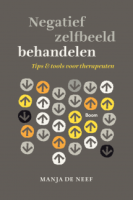Inhoud
UCS-reinstatement en UCS-inflatie bij verworven visuele beperking. Illustratie aan de hand van een gevalsbeschrijving
Samenvatting
Het krijgen van een visuele beperking heeft een aantal ingrijpende psychosociale consequenties. In de literatuur wordt steeds uitgegaan van ziektespecifieke en ziektegenerieke aanpassingstaken, die verondersteld worden min of meer universeel op te treden. Er is betrekkelijk weinig aandacht voor de activering van geconditioneerde emotionele kernthema's door de verworven beperking. In deze gevalsbeschrijving van een 59-jarige vrouw met blanco psychiatrische voorgeschiedenis wordt geïllustreerd hoe de aanpassingstaken worden bemoeilijkt doordat de visusachteruitgang twee emotionele kernthema's activeert (UCS-reinstatement) en sensitiseert (UCS-inflatie). Door behandeling van deze kernthema's middels traumaverwerking wordt de aanpassing aan de slechtziendheid vergemakkelijkt. We doen een voorstel tot een model om aanpassing aan een verworven beperking of chronische ziekte in brede zin en de rol van eerdere traumatisering te beschrijven.
Literatuur
- Andrykowski, M.A., & Cordova, M.J. (1998). Factors associated with PTSD symptoms following treatment for breast cancer: test of the Anderson model. Journal of Trauma and Stress, 11, 189-203.
- Benn, D.T. (1997). The role of personality traits and coping strategies in late-life adaptation to vision loss. Dissertation Abstracts International: Section B: The Sciences and End Engineering, 58, 2251.
- Bohlmeijer, E., Smit, F., & Cuijpers, P. (2003). Effects of reminiscence and life review on late-life depression: a meta-analysis. International Journal of Geriatric Psychiatry, 18, 1088-1094.
- Bouton, M.E. (1994). Context, ambiguity, and classical conditioning. Current Directions in Psychological Science, 3, 49-533.
- Breslau, N., Chilcoat, H.D., Kessler, T.C., & Davis, G.C. (1999). Previous exposure to trauma and PTSD effects of subsequent trauma: results from the Detroit Area Survey of Trauma. American Journal of Psychiatry, 156, 902-907.
- Cella, D.F., Mahon, S.M., & Donovan, M.I. (1990). Cancer recurrence as a traumatic event. Behavioral Medicine, 16, 15-22.
- Cicchetti, D. (2005). Child maltreatment. Annual Review of Clinical Psychology, 1, 409-438.
- Dachowski, L., & Flaherty, C.F. (Eds.). (1991). Current topics in animal learning. Brain, emotion and cognition. Mahwah, NJ: Lawrence Erlbaum Associates, Inc.
- Damme, S. van, Crombez, G., Hermans, D., Koster, E.H.W., & Eccleston, C. (2006). The role of extinction and reinstatement in attentional bias to threat: A conditional approach. Behaviour Research and Therapy, 44, 1555-1563.
- Davey, G.C.L. (1989). UCS revaluation and conditioning models of acquired fears. Behaviour Research and Therapy, 27, 521-528.
- Du Hamel, K.N., Ostroff, J.S., Bovbjerg, D.H., Pfeffer, M., Morasco, B.J., Papadopoulos, E., & Redd, M.H. (2000). Trauma-focused intervention after bone marrow transplantation: a case study. Behaviour Research and Therapy, 31, 175-186.
- Duhault, J.L. (2002). Stress prevention and management: a challenge for patients and physicians. Metabolism, 51, 46-48.
- Edskes, K.H. (2009). De tussenstop. CGT-behandeling van chronische PTSS een aanpassingsstoornis bij een 59-jarige vrouw met verworven visuele beperking. Niet gepubliceerd.
- Galvin, L.R., & Godfrey, H.P.D. (2001). The impact of coping on emotional adjustment to spinal cord (SCI): review of the literature and application of a stress appraisal and coping formulation. Spinal Cord, 39, 615-627.
- Glanz, K., Rimer, B.K., & Lewis, R.M. (2002). Health Behavior and Health Education. Theory, Research and Practice. San Francisco: Wiley & Sons.
- Green, B.L., Krupnick, J.L., Rowland, J.H., Epstein, S.A., Stockton, P., Spertus, I., & Stern, N. (2000). Trauma history as a predictor of psychological symptoms in women with breast cancer. Journal of Clinical Oncology, 18, 1084-1093.
- Gurevich, M., Devins, G.M., & Rodin, G.M. (2002). Stress syndrome responses and cancer: conceptual and assessment issues. Psychosomatics, 43, 259-283.
- Jong, P.J. de, Muris, P., & Merckelbach, H. (1996). UCS inflation and human aversive autonomic conditioning. Biological Psychology, 43, 227-239.
- Jonker-Pool, G. (2000). Meaning in life after the trauma of cancer. Research proposal for the Dutch Cancer Society. Groningen: Noordelijk Centrum voor Gezondheidsvraagstukken.
- Kaptein, A. (1997). Asthma. In: A. Baum, S. Newman, J. Weinman, R. West & C. McManus (Eds.), Cambridge Handbook of Psychology, Health and Medicine, (371-372).
- Kemp, A., Green, B.L., Hovanitz, C., & Rawlings, E.I. (1995). Incidence and correlates of posttraumatic stress disorder in battered women: shelter and community samples. Journal of Interpersonal Violence, 10, 43-55.
- Kendler, K.S., Hettema, J.M., Butera, F., Gardner, C.O., & Prescott, C.A. (2003). Life event dimensions of loss, humiliation, entrapment and danger in the prediction of onsets of major depression and generalized anxiety. Archives of General Psychiatry, 60, 789796.
- King, D.W., King, L.A., Foy, D.W., & Gudanowski, D.M. (1996). Prewar factors in combat related posttraumatic stress disorder: Structural equation modeling with a national sample of female and male Vietnam veterans. Journal of Consulting and Clinical Psychology, 64, 520-531.
- Korrelboom, C.W., & Broeke, E. ten (2004). Geïntegreerde cognitieve gedragstherapie: Handboek voor theorie en praktijk. Muiderberg: Coutinho.
- Korrelboom, C.W., & Kernkamp, J.H.B. (1993). Gedragstherapie. Muiderberg: Coutinho.
- La Heij, E.C., & Hendrikse, F. (1999). Stand van zaken. Netvliesloslatingen en netvlieschirurgie. Nederlands tijdschrift voor de geneeskunde, 143, 781-785.
- Lang, P.J. (1985). The cognitieve psychophysiology of emotion: fear and anxiety. In: A.H.Tuma & J. Maser (Eds.), Anxiety and the anxiety disorders. Hillsdale, New Jersey, London: Lawrence Erlbaum Associaties, Publishers.
- Lazarus, R., & Folkman, S. (1984). Stress Appraisal and Coping. New York: Springer.
- Limburg, H. (2007). Epidemiologie van visuele beperkingen en een demografische verkenning. Grootebroek: Health Information Services .
- Livneh, H., & Antonak, R.F. (1997). Psychosocial adaptation to chronic illness and disability. Gaithersburg, MD: Aspen.
- Luszczynska, A., Benight, C.C., & Cieslak, R. (2009). Self-efficacy and health-related out comes of collective trauma: A systematic review. European Psychologist, 14, 51-62.
- Maes, S., Leventhal, H., & Ridder, D.T.D. de (1996). Coping with chronic diseases. In: M. Ziender & N. Endler (Eds.), Handbook of coping. Chichester: John Wiley & Sons.
- Mahat, G. (1997). Perceived stressors and coping strategies among indidviduals with rheuamatoid arthritis. Journal of Advanced Nursing, 25, 1144-1150.
- McEwen, B.S. (2003). Mood disorders and medical illness. Mood disorders and allostatic load. Biological Psychiatry, 54, 200-207.
- McMahon, S.D., Grant, K.E., Compas, B.E., Thurm, A.E., & Ey, S. 2003). Stress and psychopathology in children and adolescents: Is there evidence of specificity? Journal of Child Psychology and Psychiatry, 44, 107-144.
- Mueller, D., & Stewart, J. (2000). Cocaine-induced conditioned place preference: reinstatement by priming injections of cocaine after extinction. Behavioural Brain Research, 115, 39-47.
- Nederlands Oogheelkundig Gezelschap (NOG). Richtlijn "Verwijzing van Slechtzienden en Blinden"(2004). VU Medisch Centrum, Amsterdam .
- Olley, B.O., Seedat, S., & Stein, D.J. (2006). Persistence of psychiatric disorders in a cohort of HIV/AIDS patients in South Africa: a 6-month follow-up study. Journal of Psychosomatic Research, 61, 479-484.
- Rao, S.M., Huber, S.J., & Bornstein, R.A. (1992). Emotional changes with multiple sclerosis and parkinson's disease. Journal of Consulting and Clinical Psychology, 60, 369-378.
- Reinhardt, J.P. (2001). Effects of positive and negative support received and provided on adaptation to chronic visual impairment. Applied Developmental Science, 5, 76-85.
- Rescorla, R.A., & Heth, C.D. (1975). Reinstatement of fear to an extinguished conditioned stimulus. Journal of Experimental Psychology: Animal Behavior Processes, 1, 88-96.
- Schneiderman, N., Ironson, G., & Siegel, S.D. (2005). Stress and health: Psychological, behavioral, and biological determinants. Annual Review of Clinical Psychology, 1, 607-628.
- Schumm, J.A., Stines, L.R., Hobfoll, S.E., & Jackson, A.P. (2005). The double-barreled burden of child abuse and current stressful circumstances on adult women: The kindling effect of early traumatic experience. Journal of Traumatic Stress, 18, 467-476.
- Solomon, Z., Garb, R., Bleich, A., & Grupper, D. (1987). Reactivation of combat-related post-traumatic stress disorder. American Journal of Psychiatry, 144, 51-55.
- Van Houdenhove, B., & Egle, U.T. (2004). Fibromyalgia, a stress disorder? Piecing the biopsychosocial puzzle together. Psychotherapy and Psychosomatics, 73, 267-275.
- Wahl, H.W., Heyl, V., & Langer, N. (2008). Lebensqualität bei Seheinschränkung im Alter. Der Ophthalmologe, 105, 735-741.
- Whalley, D., McKenna, S.P., de Jong, Z., & van der Heide, D. (1997). Quality of life in rheumatoid arthritis. British Journal of Rheumatology, 36, 884-888.
- Wouters, B. (2002a). Blindheid en slechtziendheid. In: G.A.H ten Dam-Boschloo. (Red.), Handboek handicap & chronische ziekte. III-3-2-1/25. Maarssen: Elsevier gezondheidszorg.
- Wouters B. (2002b). Revalidatie van mensen met een visuele beperking. In: G.A.H. ten Dam-Boschloo (red.), Handboek handicap & chronische ziekte. III-3-2-1/22. Maarssen: Elsevier gezondheidszorg.
 © 2009-2025 Uitgeverij Boom Amsterdam
© 2009-2025 Uitgeverij Boom Amsterdam
De artikelen uit de (online)tijdschriften van Uitgeverij Boom zijn auteursrechtelijk beschermd. U kunt er natuurlijk uit citeren (voorzien van een bronvermelding) maar voor reproductie in welke vorm dan ook moet toestemming aan de uitgever worden gevraagd:
Behoudens de in of krachtens de Auteurswet van 1912 gestelde uitzonderingen mag niets uit deze uitgave worden verveelvoudigd, opgeslagen in een geautomatiseerd gegevensbestand, of openbaar gemaakt, in enige vorm of op enige wijze, hetzij elektronisch, mechanisch door fotokopieën, opnamen of enig andere manier, zonder voorafgaande schriftelijke toestemming van de uitgever.
Voor zover het maken van kopieën uit deze uitgave is toegestaan op grond van artikelen 16h t/m 16m Auteurswet 1912 jo. Besluit van 27 november 2002, Stb 575, dient men de daarvoor wettelijk verschuldigde vergoeding te voldoen aan de Stichting Reprorecht te Hoofddorp (postbus 3060, 2130 KB, www.reprorecht.nl) of contact op te nemen met de uitgever voor het treffen van een rechtstreekse regeling in de zin van art. 16l, vijfde lid, Auteurswet 1912.
Voor het overnemen van gedeelte(n) uit deze uitgave in bloemlezingen, readers en andere compilatiewerken (artikel 16, Auteurswet 1912) kan men zich wenden tot de Stichting PRO (Stichting Publicatie- en Reproductierechten, postbus 3060, 2130 KB Hoofddorp, www.cedar.nl/pro).
No part of this book may be reproduced in any way whatsoever without the written permission of the publisher.
Inloggen VGCt en VVGT
Leden van de VGCt en de VVGT loggen in via de site van hun vereniging. Als u op die site bent ingelogd als lid, vindt u daar een button naar het Tijdschrift voor Gedragstherapie.
English
Behavioral Therapy: Journal for Behavioral Therapy and Cognitive Therapy ISSN 0167-7454
Information in English can be found here.



